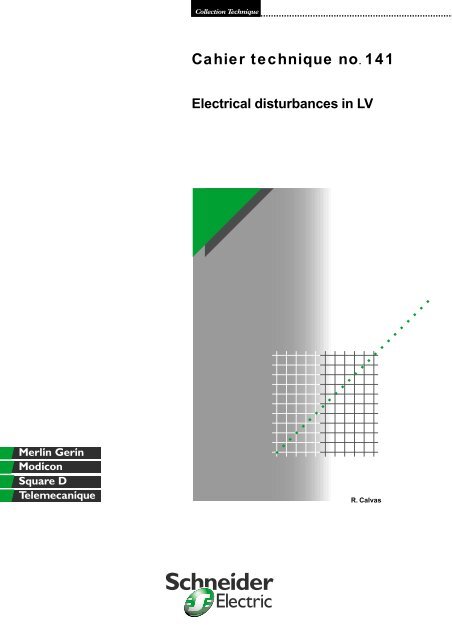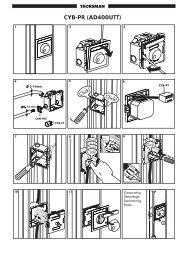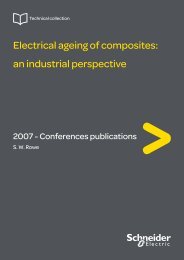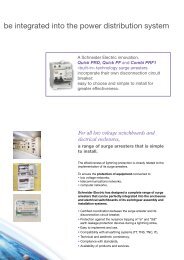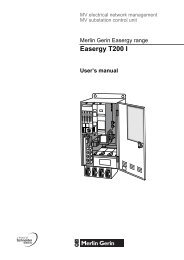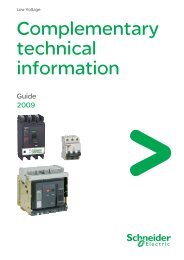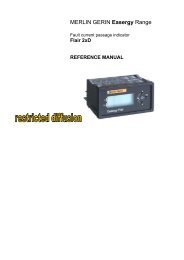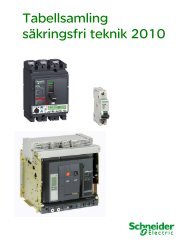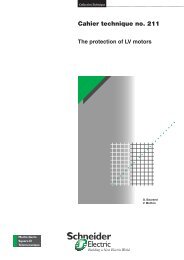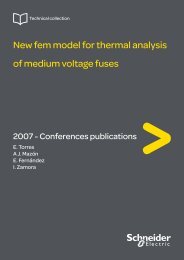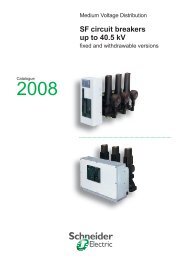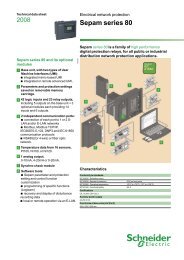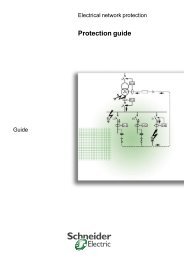Download - Schneider Electric
Download - Schneider Electric
Download - Schneider Electric
You also want an ePaper? Increase the reach of your titles
YUMPU automatically turns print PDFs into web optimized ePapers that Google loves.
Collection Technique ..........................................................................Cahier technique no. 141<strong>Electric</strong>al disturbances in LVR. Calvas
"Cahiers Techniques" is a collection of documents intended for engineersand technicians, people in the industry who are looking for more in-depthinformation in order to complement that given in product catalogues.Furthermore, these "Cahiers Techniques" are often considered as helpful"tools" for training courses.They provide knowledge on new technical and technological developmentsin the electrotechnical field and electronics. They also provide betterunderstanding of various phenomena observed in electrical installations,systems and equipments.Each "Cahier Technique" provides an in-depth study of a precise subject inthe fields of electrical networks, protection devices, monitoring and controland industrial automation systems.The latest publications can be downloaded from the <strong>Schneider</strong> <strong>Electric</strong>internet web site.Code: http://www.schneider-electric.comSection: Experts' placePlease contact your <strong>Schneider</strong> <strong>Electric</strong> representative if you want either a"Cahier Technique" or the list of available titles.The "Cahiers Techniques" collection is part of the <strong>Schneider</strong> <strong>Electric</strong>’s"Collection technique".ForewordThe author disclaims all responsibility subsequent to incorrect use ofinformation or diagrams reproduced in this document, and cannot be heldresponsible for any errors or oversights, or for the consequences of usinginformation and diagrams contained in this document.Reproduction of all or part of a "Cahier Technique" is authorised with theprior consent of the Scientific and Technical Division. The statement"Extracted from <strong>Schneider</strong> <strong>Electric</strong> "Cahier Technique" no. ....." (pleasespecify) is compulsory.
no. 141<strong>Electric</strong>al disturbances in LVRoland CALVASENSERG 1964 graduate (Ecole Nationale Supérieure d’Electroniqueet Radioélectricité de Grenoble: Grenoble Higher Institute ofElectronics and Radioelectricity) and graduate from the Institutd’Administration des Entreprises (Corporate Administration Institute),he joined Merlin Gerin in 1966.During his career he has been sales manager, then marketingmanager of the activity concerned with protection of people againstelectrical hazards.ECT 141 first issue, March 2000
LexiconEarthing systems:Standard IEC 60364 (in France standardNF C 15-100) stipulates the three main officialearthing systems defining the possibleconnections of the neutral, source and frames tothe earth or neutral. The necessary electricalprotection devices are defined according to theearthing system chosen for a network.<strong>Electric</strong>al disturbance:All disturbing phenomena that cause the mainsvoltage (or current) wave to depart from itsnominal characteristics.Electromagnetic disturbance:All disturbing phenomena of an electrical,magnetic or electrostatic nature that may affectthe mains and/or the operation of electric andelectronic devices.Impulse voltage:Impulse lasting less than 10 ms superimposedon sinusoidal voltage.Interruption:Absence of voltage for a varying period of time.Overvoltage:Overshooting Un + 10% for a varying period oftime.PWM: Pulse Width Modulation.r.m.s. : root mean square.Short overvoltage:Transient voltage wave characterised by a rapidincrease followed by a slower decrease,normally of a periodic nature.Very short overvoltage:Transient voltage wave characterised by a rapidincrease followed by a slower decrease,normally of a periodic nature.Voltage dip:Voltage drop of more than 10% followed by areturn to the normal variation range.Cahier Technique <strong>Schneider</strong> <strong>Electric</strong> no. 141 / p.2
1 LV industrial voltagesAll networks undergo or create disturbances.However, loads, as well as control/monitoringand protection devices, are sensitive to thequality of the voltage applied to them. Knowledgeand consideration of these electrical powersupply requirements are thus justified:c manufacturers of electrotechnical andelectronic equipment designed for aninternational market must allow for tolerancesthat vary from country to country,c electrical consultants and contractors mustalso take these phenomena into account rightfrom the design stage of networks, and,according to their customers’ needs, findtechnical solutions for distribution diagrams andswitchgear.Important reminder:Low Voltage installations must comply withstandard IEC 60364 (in France standardNF C 15-100).1.1 Nominal voltagesThe low voltage range concerns the followingvoltages:c AC: i 1,000 V(frequency i 10 kHz),c DC: i 1,500 VAlso known as “rated voltages” they are definedin publication IEC 60038 of 1983. The mostcommon LV voltage is “230/400 V” in France,made official by the decree of 29/05/86.World-wide and up to 2003, various nominalvoltages will continue to be found:c European: 220/380 V, 50 Hz,c English: 240/415, 50 Hz,c USA: 120/240 V and 480 V, 60 Hz,c Japan: 100/200 V, 50 and 60 Hz.However, these voltages vary around nominalvoltage according to structure and load of thenetwork (conductor length and load fluctuation)and the regulating systems of the public (orprivate) network.In Europe, standard EN 50160 states that innormal operation, for each period in a week,95% of r.m.s. values averaged out over10 minutes must be included in the rangeUn ± 10%. For example, in France, the UtilityCompany (EDF) announces a fluctuation of ± 10%but accepts that, temporarily, voltages maydepart from nominal voltage by more than 20%.Furthermore, these fluctuations must beassociated with the notion of time, e.g.:c Permanent Un ± 10%.c Five minutes Un ± 20%.In developing countries, fluctuations in excess of± 20% can be frequently observed.1.2 FrequencyWith respect to frequency, slow fluctuationsaround the nominal value of 50 or 60 Hz arenormally small.In European countries, whose networks areinterconnected, standard EN 50160 specifies50 Hz ± 1% for 95% of the week, and[+4%, - 6%] in the event of major disturbances.These fluctuations may be far greater forautonomous networks, for example on anisland.Cahier Technique <strong>Schneider</strong> <strong>Electric</strong> no. 141 / p.4
2 Amplitude disturbancesNetworks are disturbed not only by loadfluctuations in normal operation, but also andabove all by random phenomena of accidentalorigin, for example short-circuits. A LV networkis subjected to these two causes of disturbanceswhatever their origin (LV, MV or HV). The twomain amplitude disturbances are:c voltage dips and short interruptions,c overvoltages.2.1 Voltage dips and short interruptionsA voltage dip is normally defined as a drop from10% to nearly 100% of the nominal voltage valuefor a time lasting between 10 ms and a fewseconds (see fig. 1 ). When power is off (100 %voltage drop), for 1 s to 1 min, we talk of a “shortinterruption”, and of a “very short interruption”between 10 ms and 1 s. When duration isi 10 ms, the interruption is normally due to“transient” or voluntary phenomena, such as useof dimmers.Voltage amplitude∆ v10 % 10 msn transformerTime constant(s)50 15 0.1100 14 0.15160 12 0.2250 12 0.22400 12 0.25630 11 0.3800 10 0.31000 10 0.351250 9 0.351600 9 0.42000 8 0.45InterruptionFig. 2 : value of the energising currents and timeconstant of the MV/LV transformers on energisation onthe MV side (on energisation on the LV side, “ne” istwice as high).Cahier Technique <strong>Schneider</strong> <strong>Electric</strong> no. 141 / p.5
In Francev On EHV networks (400 and 225 kV), variousreclosers are used:- slow single-phase reclosers tripping in eventof single-phase faults: breaking time is around1.5 to 2 s,- slow three-phase reclosers (multiphase faults),whose operation depends on voltagesynchronisation check: breaking time is around5 s. These reclosers are also used onHV networks (90 and 63 kV).v On overhead MV networks (5 to 20 kV) forwhich the neutral is earthed by an impedancelimiting the earth fault current to 300 A in theprimary substation, “shunt circuit-breakers”eliminate intermittent single-phase faults(contacts with branches) without affectingLV users (see fig. 3 ).However, multiphase faults are treated by rapidand slow reclosers that cause voltage dips onLV (see fig. 4 ). Roughly 75% of faults areeliminated after rapid reclosing that correspondsto the conventional short 300 ms interruption.v On underground MV networks (5 to 20 kV).In theory there are no intermittent faults, thus allfaults result in “permanent” de-energisation ofthe faulty part of the network. Consequentlyunderground networks (town) are organisedeither in “double shunt” (see fig. 5 ) or, in mostcases, in an open ring (see fig. 6 ).Automated systems restore supply to fault-freeHV/LV substations in less than one minute.N300 A Shuntcircuit-beakerFig. 3 : elimination of a single-phase fault by a shuntcircuit-breaker which short-circuits the fault, thusquenching the arc.a - Current inrush by the faulty feederIn0t (s)HVb - Voltage on the faulty feederMVUn0∆ut (s)Faulty feederc - Voltage on the other feedersUn0∆ut (s)Originof fault0.1 0.3 0.5 150.5 PermanentRapidreclosingSlowreclosingCircuit-breakeropeningCircuit-breakeropeningCircuit-breakeropeningPrinciple: On an overhead MV network, most faults are intermittent. Thus, the incoming circuit-breaker oneach feeder is equipped with an automated system that attempts two reclosings (sometimes three):c the first instantaneously (opening + closing time: 0.3 s),c the second after roughly 15 s.Fig. 4 : voltage fluctuations on rapid and slow reclosing on a MV distribution network.Cahier Technique <strong>Schneider</strong> <strong>Electric</strong> no. 141 / p.6
HV/MVsubstationHV/MVsubstationCircuit “A”Circuit “B”UIncomer“A”Incomer“B”Networksuppliedby…101010AtfBtfAtf = 5 or 25 stFig. 5 : double shunt MV power supply. In the box, automated system sequence for a Merlin Gerin changeoverswitch conform to EDF specifications (France).HV/MV transformersHV/MVsubstationSupply path of all substations except no. 1Supply path ofsubstation no. 1MV/LVtransformersMV/LVtransformersSubstation no. 1Ring openingpointMV/LVtransformersFig. 6 : open ring MV power supply (main feeder interruption).Cahier Technique <strong>Schneider</strong> <strong>Electric</strong> no. 141 / p.7
Disturbances due to operation ofLV networksThe voltage dips observed on LV networks, dueto their operation, are caused by:c activation of capacitors (possibly placed at thesupply end of the network) that causes, just as inMV, a very short voltage dip or a transientphenomenon of the oscillating kind;c direct on line starting of large motors, directlysupplied by the main LV board, that causes avoltage dip or whose catching a spinning load(resumption of supply after a short interruption)results in an inrush current that may be high (upto twice the 8 to 10 In of an across the line start).Disturbances due to faults on LV networksShort-circuits on the main LV distribution,between two live conductors or between a liveconductor and a frame in the TN earthing system(see “Cahier Technique” no. 172) are alsoresponsible for voltage dips and interruptions.These short-circuits eliminated by circuitbreakers,selective or otherwise, cause a voltagedip that is particularly “deep” if the faulty feederis important for source power, and that can lastfrom 50 to 500 ms. The shape of some voltagedips and interruptions is given in the table infigure 7 .Note that LV networks backed up by rotatingsets and source changeover switches (main/standby) may not be powered for severalseconds (see “Cahier Technique” no. 161):Breaking time = T1 + Td + T, where:T1 = unit starting time delay (0.4 to 10 s),Td = unit starting time (a few seconds),T = changeover time (< 0.4 s).Orders of magnitude of voltage dips according tovarious switching types are given in the table infigure 8 .Conclusion concerning voltage dips andshort interruptionsStatistically we observe interruptions and voltagedips, at the supply end of a LV network, at afrequency of once a month to 10 times a day.They are mainly found in medium and highvoltage, and in 80% of cases last between20 and 350 ms.Electrotechnical switchgear is normallyunaffected by these phenomena, except forcontactors and relays whose nuisance “tripping”and “switching” may be a source of majorproblems in industrial processes.With the growth of distributed intelligence andmicro-PLCs, sensors, intelligent pre-actuators, etc.great attention should be paid to equipmentimmunity to voltage dips and supplyinterruptions. As a matter of fact, switchgearusing electronic components must not giveincorrect indications or untimely orders.c Voluntary source switchingDuration: a few milliseconds to several minutes.Unc Automatic source switching further to anexternal faultDuration: a few milliseconds to 10 s.Unc External short-circuitDuration: 10 ms to more than 100 ms.Unc Energisation of a large unitDuration: depends on network power.Unc Short interruptions with large motor and catching aspinning load.UnFig. 7 : main types of interruptions and voltage dips.tttttCahier Technique <strong>Schneider</strong> <strong>Electric</strong> no. 141 / p.8
Type of switchingSynchronous Idle time PseudosynchronousLVMVApplication examples c Busbar switching c Pump supply c Supply by two c Catching a spinning loadc Substitution of one c Supply of auxiliary switchable MV incomers of asynchronous motorsgenerator for another circuits of a transformer c Supply by one mainc Switching between a substation source and oneUPS and the mains c Supply of hypermarkets replacement sourcec Etc.Switching duration None 0.5 to 10 s 1 to 30 s 0.06 to 0.3 sDevices used c Coupler c Automatic source c Set of MV cubicles with c Rapid HV circuit-breakersc Synchrocoupler changeover switch with changeover switch associated with an ultracUPS assembly with circuit-breakers rapid changeover switchstatic switchand a phase controllerObservations Switching must be The changeover devices mentioned above are Problems in preparingperformed before normally factory-assembled, cabled and adjusted the switching orderall power is cut to assemblies (see for example the <strong>Schneider</strong> <strong>Electric</strong> (residual voltage present)the main sourcecatalogue)Fig. 8 : various types of switching and their duration.2.2 OvervoltagesExcept for accidental voltage rises, for exampleconnection of a 230 V transformer to a 400 Vline, the only voltage rises that may exceed thenominal variation range of Un + 10% areobserved when the LV network is not on-load.However, the transformers of primarysubstations are normally equipped with on-loadtap changers that enable the electrical utility tomaintain MV within the range Un ± 7%.Impulse overvoltages are mainly due toswitching operations on the network and tolightning. While without major risk forconventional LV switchgear built tomanufacturing standards, they can affectdevices containing electronic components(voltage withstand reduced to 1,500 V).Switching on the MV networkc Energisation of MV capacitor banks without ablocking reactor: peak value may reach 2 Un(see fig. 9 ).c De-energisation of MV/LV transformers: peakvalue may reach 3 Un: it considerably dependson the current “chopped” by the MV breakingdevice (see fig. 10 ).These overvoltages are transmitted to the LV bythe MV/LV transformer according to its inductiveand capacitive ratios (see appendix 2). Theymust not be ignored as they represent a risk forLV switchgear particularly when the LV circuit isweakly capacitive, i.e. small. This is particularlythe case on commissioning of an installation.Un10-1-2 UnEnergisationFig. 9 : voltage wave on energisation of aMV capacitor bank.Un1-1Fig. 10 : voltage wave on tripping of aMV/LV transformer.-20 (ms)ttCahier Technique <strong>Schneider</strong> <strong>Electric</strong> no. 141 / p.9
LightningLightning directly affects overhead networks.Many studies deal with this subject.Not all regions are equally exposed: we talk oflightning density level.Likewise, not all installations are equallyexposed. Extreme exposure applies to very longoverhead lines in regions that are particularlyaffected by storms. Figure 11 shows the numberand level of overvoltages that can be expectedto be observed over one year. These arestatistical values and there is always the risk of adirect lightning stroke of a far higher value.Standards concerning insulation co-ordination andelectromagnetic compatibility (EMC) take accountof this natural phenomenon that develops aconsiderable impulse energy transmitted toLV networks by the MV/LV transformers.Switchgear standards increasingly makeprovision for withstand to voltage and currentwaves representative of lightning.In addition to these steep front “waves”, lightninghas a perverse effect due to the spark-gaps andsurge arresters placed upstream ofMV/LV substations.Number of overvoltages a year(without protection)10 310 210110 -110 -2LowexposureHigh exposureExtreme exposure0.2 0.5 1 2 5 10 20Device arcingOvervoltagelevels (kV)Fig. 11 : number and value of overvoltages statisticallypossible according to the level of exposure to lightning.The importance of the risk depends on theearthing system (see standard NF C 13-100).Take the case of the TTN earthing system(see fig. 12 ).When lightning strikes the MV line, it causesarcing in the spark-gap or surge arrester, whichlets through part of the impulse wave, that maybe amplified by the wave reflection phenomenon(see “Cahier Technique” no. 168).This spark-gap arcing results in a 50 Hz current,from the faulty phase to the Rpn earthingconnection. This current, limited by theZ impedance (at 300 A in France) is maintaineduntil the protection devices in the primarysubstation trip. When it flows through Rpn itresults in a potential increase of the entireLV network with respect to the deep earth towhich the LV equipment is connected by Ra.There is then a risk of “return breakdown” of theLV equipment which is concretised when the“Current x Rpn” product is greater than insulationvoltage with respect to the equipment frame.Thus, with a 300 A current and a 2500 Vinsulation voltage, Rpn must not exceed 8 W, avalue that can be exceeded according to thehydraulicity and nature of the land!Note that the problem is the same for an earthfault of an MV device in the substation. In thiscase, the underground MV networks present thegreatest risk as this current is either limited to ahigher value (1000 A in France) or not limited asis the case in some countries.The 2 U + 1000 test at 50 Hz for 1 min enablesthe voltage withstand of LV equipment to bechecked.Finally, the substation earthing system plays animportant role with respect to transmission of theimpulse wave to the LV. As a matter of fact, inaddition to the overvoltage due to capacitivetransmission through the transformer, thelightning current wave develops a voltage U l inthe earthing connection impedance, as high asthe earthing connection is inductive (see fig. 12).U lNZSpark-gapU lPrimary substationRpnU lMV/LV substationRaLoadFig. 12 : TTN earthing system of a MV/LV substation (common earthing of the spark-gap, transformer frame andLV neutral), and transmission of the lightning wave to the LV network.Cahier Technique <strong>Schneider</strong> <strong>Electric</strong> no. 141 / p.10
To allow for this phenomenon, “pole-top”substations in France are installed (see fig. 13 )with separate substation, neutral and LV loadearthing connections (this is known as aseparate earthing connection diagram, TTS asper NF C 13-103).This arrangement avoids potential increase ofthe LV installation and thus prevents the risk ofreturn breakdown of switchgear and LV loads(see fig. 14 ).Their manufacturing standards mean thatMV equipment can withstand these overvoltages(125 kV impulse wave withstand for a devicewith a specified voltage of 24 kV). On anHV/LV breakdown in the transformer, it is thevalue of Rn or Rpn that prevents returnbreakdowns in the LV equipment.Readings, mainly made in Switzerland by Landis& Gyr, and mainly published by the I.E.E.E., showthat transient overvoltages in excess of 1 kV areobserved several times a year at various pointsof a LV distribution network (see fig. 15 ).It is relatively exceptional to detect overvoltagesgreater than 6 or 7 kV as, at these levels, arcingoccurs in the air or in the cabling that acts as aspark-gap. Such arcing or dielectric breakdownclips overvoltages to a level that is particularlylow for a careless wiring. Such a “protection”damages the installation and may in time lead toserious safety problems by piercing, bypassingand carbonising of insulators. The solution forexposed sites is to use surge arresters betweenthe live conductors and the earth. For moredetails refer to “Cahier Technique” no. 179.MV/LVtransformerLV “pole-top”protectionMetering“Individual”LV protectionRp Rn RaFig. 13 : MV/LV “pole-top” substation. TTS earthing system of a MV/LV substation (separate earthing of the sparkgap,transformer frame and LV neutral). This earthing system is ITS if a surge limiter is inserted in the LV neutralearthing connection.Number of transients a yearRp Rn RaRp i 30 Ω as the substation equipment (pole-toptransformer and circuit-breaker) isoverinsulated at 20 kV impulse.Rn i 4 Ω to cover the risk of return breakdown ofthe consumer’s LV equipment further toHV/LV breakdown, this value results fromthe following calculation:Rn i 2 x U + 1,000 - U300 ARn i2 x 220 + 1,000 - 220300= 4 ΩFig. 14 : earthing connections of a MV/LV substationsupplied by overhead lines.2,0001,0002001002010210.20.10.020.01Home (living roomon upper floor)Landis &Gyr plant(furnaceroom)Home(undergroundincoming supply)0.10.20.3 0.70.5Landis & Gyr plant(laboratory)Bank in Basel(service entrance)Farm suppliedby overheadlinesCompositecurve in USA120 V networkFig. 15 : frequencies and peak values of overvoltagesdue to lightning on LV installations (source: Landis &Gyr).kV1 23 5 7 10 20Cahier Technique <strong>Schneider</strong> <strong>Electric</strong> no. 141 / p.11
Switchgear operations and operation of theLV protection devicesc Relay and contactor coils have an inductiveimpedance. Breaking of an “inductive current”nearly always results in high overvoltages. In thecase of a relay (see fig. 16 ), when the current issuddenly broken by the switch K, the energy1/2 Li 2 is converted into energy 1/2 CV 2 , hencean overvoltage:−1L10V = i = 015 .= 3,000 V− 9C025 . x 10The overvoltages observed may reach nearly10 kV on a 230 V circuit.Interference must be suppressed on thesecontrol auxiliaries by their manufacturers, or aRC network or a varistor, connected in parallel ontheir coil, enables overvoltage to be absorbed.c On LV and HV networks, no-load or only onminimum load, breaking a low inductive current isnot easy and results in creation of overvoltagesthat are frequently multiple (wave trains).On the single-phase circuit in figure 17, taken asan example, when switch K is opened, currentcontinues to flow in L 2 with, at the terminals ofC 2 , the voltage V BN :LVBN = 2iCsin ω2t2The same applies to the upstream network withat the terminals of C 1 the voltage:LVAN = 1iCsin ω1t1On opening, voltages V BN and V AN evolve inopposition, and voltage V AB quickly becomeshigh enough to cause arc re-arcing (re-arcingbetween the contacts of breaking device K).The current to be broken is small, the contactsmove apart, and the interference between thetwo voltages V BN and V AN are elements thatextinguish the arc. Then the voltages begin torise again and the phenomenon is repeated…Several cycles known as re-arcing can thusoccur until the energy lost by the arc and theincreasing distance between contacts interruptthe phenomenon.The result is the appearance of wave trains,1of high voltage and frequency (ω =LC ),that are genuine interference generators.The presence of different no-load circuits withreactor or transformer, and of slow openingbreaking devices, means that this phenomenonis fairly frequent. It is even observed on shortcircuitcurrent breaking, when at the end ofbreaking the current becomes sufficiently smallto be “chopped”.c Breaking a short-circuit current can alsopresent a risk of overvoltage as:v rapid action must be taken, before the currentreaches prospective short-circuit current,v and “insert”’ in the circuit an arcing voltage thatis not always easy to control according to thebreaking conditions, as this voltage constitutesan overvoltage of several hundred volts forcircuit-breakers and sometimes several kV forfuses (see fig. 18 ).iLRL = 100 mHR = 180 ΩC interference = 250 pFi = 150 mAC interferenceFig. 16 : equivalent diagram of a network.L 1 K L 2A BeC 1 C 2NL 1 , C 1 = inductance and capacitance of theupstream networkL 2 , C 2 = inductance and capacitance of thedownstream networkFig. 17 : equivalent diagram of a single-phase circuit.C32L circuit- GL fusebreakerProspective Isc (kA) 11 420ACos ϕ 0.25 0.3U (V) 380+10% 380+10%Overvoltage (V) 400 to 650 2,100 toU+∆U 2,650Fig. 18 : overvoltages recorded with two protectiondevices tested on the same test installation.Cahier Technique <strong>Schneider</strong> <strong>Electric</strong> no. 141 / p.12
With respect to this last point, note that:v the closer the short-circuit occurs to thedownstream terminals of the breaking device,the higher and shorter the overvoltage. Thus theresults presented in figure 19 were read for afault observed on a 1.5 mm 2 diameter cabledownstream of a 10 A fuse:where L = 0∆ U + U 1700 + 220 2== 6.4 and T = 50 µsU 220 2where L = 20 m∆ U + U= 2 and T = 200 µsUv generally, the higher the feeder protectionrating (and thus the greater the cross-sectionof its conductors) with respect to the short-circuitpower of the “busbar”, the longer and lower theovervoltage.Figure 20 shows a graphic summary of severaltests.VT∆UFuse∆U/2LUt10msFig. 19 : overvoltage depends on the distance separating the fault from the protection device.∆Û + ÛÛ10510 AFuse3235 A400 A1t0.03 0.1 0.3 1 3 msFig. 20 : with the same upstream short-circuit power, overvoltage levels and durations on a feeder depend on therating of its protection device and the cross-section of its conductors.Cahier Technique <strong>Schneider</strong> <strong>Electric</strong> no. 141 / p.13
FerroresonanceThis phenomenon may occur on no-load andslightly loaded networks, particularly in highvoltage, as well as behind small transformersand in the presence of filters.Readers wishing to know more can consultappendix 3 and read “Cahier Technique” no. 190.Overvoltage tests and solutionsThe impulse overvoltages transmitted byconduction, with an inductive or capacitive effect,are very dangerous in particular for electronicdevices. In this area, experience has enabledtests to be defined.c Standardised waves for equipment testingThese are mostly (see fig. 21 ) dealt with in theIEC 61000 publications, particularly 61000-4-4,61000-4-5 and 61000-4-12 (see appendix 3).In addition to waveforms, standards stipulatelevels corresponding to conditions of use andto test voltages for equipment manufacturers.For example, figure 22 gives, for the variousOrigin Wave type Test waveSwitching Damped long wave: av0.25 / 2.5 ms50%0.252.5tmsRecurrent dampedoscillating wave:(100 kHz
levels, the voltages for the impulse voltage wavetest (see curve d on figure 21).c Overvoltage solutionsThese are applied both when equipment isimplemented and chosen:v on installation, it is advisable to removeovervoltage sources away from the mostsensitive items of equipment and to monitorequipment equipotentiality;v when choosing, it may prove useful to provide:- electrostatic shielding or capacitors(see appendix 3),- screen transformers,- filters,- surge limiters (see fig. 23 ).Low voltage surge limiters are also availabledesigned for installations with an IT earthingsystem (with unearthed neutral). Defined inFrance by standard NF C 61-740, they areintended to prevent all voltage rises due to aMV fault: “Cahier Technique” no. 179 describestheir implementation.Level1 0,52 13 24 4xTest voltage ± 1% (kV)SpecialLevel “x” is open: it must be defined forspecial equipment specifications.Fig. 22 : test voltages according to standardIEC 61000-4-5.Limited U(kV)I max (kA)(8/20 wave)Varistors 14 to 1,200 10 to 5,000Rectifier diode 5 to 400 10 to 1,000Fig. 23 : characteristics of the various surge limiter types.Cahier Technique <strong>Schneider</strong> <strong>Electric</strong> no. 141 / p.15
3 Sine wave disturbancesVoltages (waves) observed, permanently ortemporarily, on networks are never completelysinusoidal. This is because:c generators are more or less perfect,c transformers are also imperfect,c loads generate or absorb harmonics,c the network conveys various signals (carriercurrents).3.1 GeneratorsInexpensive devices, normally low power, areoften harmonic-generators (see fig. 24 ).Generators(presence of a slot “noise”)3.2 TransformersWhen they are calculated improperly, they beginto saturate as soon as voltage exceeds theirnominal value. They then absorb a nonsinusoidalcurrent (see fig. 25 ).Inverters(UPS without filtering)Fig. 24 : example of a voltage wave delivered by“inexpensive” generators.3.3 LoadsCapacitorsHarmonic currents are particularly well absorbedby capacitors when their frequency is high. Thecurrent absorbed by the capacitors is thus acaricature of the voltage of the network on whichthey are placed. Associated with inductances,they form network cleaning filters and thenabsorb a non-sinusoidal current (see “CahierTechnique” no. 152).Fluorescent tubes<strong>Electric</strong> arcs absorb non-sinusoidal currentsparticularly harmonic-loaded. “Tandem”mounting and compensation do not preventfluorescent tubes from generating harmonics.Phase control rectifiersIn most cases, they are connected to aninductive circuit and successively absorb arectangular current on each phase. At eachsemiconductor switching, the sine wave of thesupply voltage is briefly interrupted. Figure 26provides a representation of the voltage andcurrent waves.UeFig. 25 : off-load current wave absorbed by atransformer with an insufficiently large power rating.Fig. 26 : voltage and current waves distorted by aphase control rectifier.UIeICahier Technique <strong>Schneider</strong> <strong>Electric</strong> no. 141 / p.16
As regards phase controlled heating dimmers,each thyristor firing results in a supply voltagedip due to its inductive component followed by aslight voltage drop linked to the internalresistance of the power supply (see fig. 27 ).UI3.4 Switch mode power suppliesVery common (microcomputers, TV sets, electricalhousehold appliances, etc.), they use at the inputcircuit a diode bridge followed by a filteringcapacitor that generates high harmonic currents.Fig. 27 : voltage and current waves distorted by aheating dimmer.3.5 Industrial furnacesThese are real network polluters:c arc furnaces produce a genuine electric noisecontaining all the frequencies, whose amplitudedecreases with frequency,c HF induction furnaces are narrow-bandinterference generators centred on a few dozenkilohertz.3.6 Carrier currentsThese are additional signals that are deliberatelyinjected on the network by the electrical utility,for example to remotely control Day/Night tariffchanges, such as the Pulsadix system (175 Hz)used in France.These signals are audible with a car radio whenthe car passes under an HV line. Their frequencyvaries from country to country:110 Hz, 175 Hz, 183 Hz, 217 Hz, 283 Hz,317 Hz, 600 Hz, 1050 Hz, 1350 Hz.The signals are made up of pulse trains of thechosen frequency, injected according to a certaincode. Their voltage is around 10 V.Other signals conveyed by the network can alsodisturb the mains at a LV consumer:c digital communications, such as those used forBuilding Management Systems (BMS),c intercom transmissions (a few dozen kilohertz),c remote control orders (50 to 150 kHz).3.7 Effects of disturbancesAll periodic signals, whatever their waveform, canbe considered as the sum of alternating signalsof a frequency equal to that of the signal, “Thefundamental”, and multiples of that of the signal,“The harmonics”.The harmonics and the special frequenciesinjected on the network produce harmful and insome cases dangerous effects. Thus harmonics:c increase iron losses and eddy currents inmotors and transformers,c jeopardise capacitor bank service life, whoselong time protection has to take harmoniccurrents into account,c jeopardise service life of filtering capacitorsof electronic circuit power supplies,c can cause temperature rise of the neutralconductor (3 rd order harmonic currents andmultiples generated by switch mode powersupplies and fluorescent tubes, are added upand return to the source by the neutral).To avoid these risks, “long time” or “overload”overcurrent electronic protection devices(equivalent to electromechanical releasessaid to be “thermal”) must contain a circuitmeasuring the total root mean square valueof the current.Cahier Technique <strong>Schneider</strong> <strong>Electric</strong> no. 141 / p.17
Standard EN 50160 indicates, for publicdistribution networks, that “…for each period of aweek, 95% of r.m.s values of each harmonicvoltage averaged out over 10 minutes must notexceed the values stated in the table in figure 28 .Higher voltages for a given harmonic can be dueto resonance.Moreover, the total harmonic distortion provided(including all harmonics up to the 40 th order)must not exceed 8%”.To reduce harmonic currents and voltages,passive filters or active compensators can beused (see “Cahier Technique” no. 183).Odd harmonicsEven harmonicsMultiples of 3 Non multiples of 3Order Relative Order Relative Order Relativevoltage (% Un) voltage (% Un) voltage (% Un)3 5 5 6 2 29 1.5 7 5 4 115 0.5 11 3.5 6 to 24 0.521 0.5 13 317 219 1.523 1.5Fig. 28 : values of harmonic voltages at the supply points (source: EN 50160).Cahier Technique <strong>Schneider</strong> <strong>Electric</strong> no. 141 / p.18
4 Disturbances specific to multiphase systems4.1 Current and voltage unbalance<strong>Electric</strong>al networks are normally three-phase.They supply three-phase loads but also a largenumber of single-phase loads. The currentsabsorbed on the three phases are thus of differentamplitude, which results in voltage unbalances.These voltage unbalances generate negativesequence components (see fig. 29 ) that mainlylead to unwanted braking torques andtemperature rises in AC motors.In Europe, standard EN 50160 specifies“In normal operating conditions, for each periodof a week, 95% of rms values calculated over10 minutes of the negative sequence componentof the supply voltage must fall between 0 and 2%of the direct component.In some regions, unbalance may reach 3%”.In France, EDF estimates that for LV networksVi(at the customer’s), the unbalance ratio ( )Vdalthough fluctuating for the most part, is between0.5 and 2% on average.The highest ratios are observed on LV networkssupplied by a low power transformer with amajority of single-phase connections… This isthe case of pole-top substations that supply fewLV consumers with single-phase.In difficult cases, “Zig-Zag” connection is ameans of attenuating unbalance for theupstream network.Direct component Negative component Zero-sequence componentV 3 Vd 3 Vi 2ωtV 2 V 1= + +ωtVd 2 Vd 1Vi 3 Vi 1→ → → → → → → → →3Vd = [V 1 + aV 2 + a 2 V 3 ] 3Vi = [V 1 + aV 2 + aV 3 ] 3Vh = [Vi + V 2 + V 3 ]VhFig. 29 : reminder of the various components, direct, negative and zero-sequence of the three-phase system.Cahier Technique <strong>Schneider</strong> <strong>Electric</strong> no. 141 / p.19
4.2 Phase unbalanceBesides the effects of negative sequencecomponents on motors, unbalance of threephasevoltages disturbs the operation of phasecontrol thyristor devices (see fig. 30 ).Furthermore, harmonics, which modify the zeropassage of voltages, can interfere with thyristorignition synchronisation.As concerns protection against electricalhazards, this type of disturbance is also anuisance as current unbalance limits use of theNicholson set-up (pooling four currenttransformers) to detect residual currents due toan insulation fault (see “Cahier Technique”no. 114).(+)VeVsV+/-(-)tFig. 30 : effect of a voltage unbalance on a rectifier in semi-controlled Graetz bridge.Cahier Technique <strong>Schneider</strong> <strong>Electric</strong> no. 141 / p.20
5 Electromagnetic disturbances5.1 Fields and radiationsThe LV network disturbances dealt with in theearlier chapters are mainly of the “conduction”type, i.e. transmitted by conductors,transformers, stray capacitances, etc.<strong>Electric</strong>al engineers know that a device placednear a conductor conveying a large 50 Hzcurrent will collect an electromotive force byinductive coupling. This is true for all circuitsplaced in the magnetic field (see fig. 31 ).They also know that a device placed near anHV network will collect an induced voltage: this istrue for all conductors placed in the electric field(see fig. 32 ).A high current is said to “radiate” a lowimpedance magnetic field, and a high voltage to“radiate” a high impedance electric field.In point of fact, field impedance is equal to:EZc = HIn fact, all electromagnetic fields arecharacterised by the simultaneous presence ofelectrical and magnetic fields linked in what isknown as the Poingting vector:→ → →2PW ( / m) = EV ( / m) ∧ HA ( / m)Impedance Z c depends on distance andfrequency (see fig. 33 ).If for 50 Hz we can talk of a field E or H, high orlow impedance, this is because:λ1 0002π = C= , km2 π fAround a conductor through which a high currentflows, the magnetic field H decreases accordingto 1 / r (r = radius) up to λ / 2π.Near an antenna (high impedance) it is field Ethat decreases as a function of distance in 1 / r 3 .When distance exceeds λ / 2π, the two fields Eand H decrease according to 1 / r andimpedance is a constant that, in air, is equal to377 W. When transmission of interference is, forexample, due to fuse blowing, as wave risingedge is 5 ns, the equivalent frequency is 10 8 Hz.The transition distance is:λ52π = C= cm, beyond this value the2 π ffields E and H decrease in 1 / r; we say we are ina “flat wave”.(S)→H =→e = -I2πred∅dt(A/m)∅ (s) = ∫ ∫ (s)µ H n ds (Weber)Fig. 31 : voltage induced by a current.DdFig. 32 : example of an electric field.Fig. 33 : example of wave impedance for a bipole.I(Volt)VrH→E =V (V/m) D→e = E d (Volt)<strong>Electric</strong> fieldZ 0=µ 0ε 0= 377 ΩFlat wave Z c = Z 0Magnetic fieldλ/2π Log (r) or (d)Cahier Technique <strong>Schneider</strong> <strong>Electric</strong> no. 141 / p.21
There is a large diversity of radiated disturbancesources, normally divided into two major families:c those with a narrow spectrum: radiotransmitters, radars, induction furnaces,microwaves, etc.c those with a wide spectrum: lightning,electrostatic discharge, breaking devices,commutator motors, welding machines, arcfurnaces, etc.Note that some sources such as staticconverters and lightning are both conducted andradiated interference generators.Electronic circuits are the main victims ofelectromagnetic disturbances since they processvery low voltage signals and have largeimpedances (they consume less and less).Interference occurs on the “victim”, mainlythrough the cables entering and leaving the box(by coupling in common mode – differentialmode – common impedance – crosstalk). Also,the paths of printed circuits and components canand must be determined to ensure minimumelectromagnetic susceptibility.The most sensitive functions are:c LF amplifiers (low-pass)c Input circuits (integrators)c Logic circuits (digital).Furthermore, growth of digital communications isresponsible for new difficulties as buses create,with the electrical network, loops that aresensitive to the magnetic fields developed by thehigh electric currents and close lightning strokes.Precautions must therefore be taken for thestudy and production of installations (see “CahierTechnique” no. 187).In LV, immunity tests against radiated fields aredefined in standard IEC 61000-4-3 andsubsequent sections. Thus, the releases of theCompact circuit-breakers of Merlin Gerin brandare tested according to the maximum degree ofseverity of standard IEC 60947-2 referring tostandards IEC 61000.Finally, to better understand electromagneticcompatibility (EMC), readers can refer to “CahierTechnique” no. 149.5.2 Electrostatic dischargesThis type of disturbance affects and/or destroyselectronic switchgear, but has no impact onelectrical networks.In point of fact, electronic components areparticularly sensitive to these electrostaticdischarges as they use increasingly more“low level” components with low consumptionand high input impedance. Also, a part of theseswitchgear, e.g. indicator lights, potentiometers,is always accessible to touch.People, depending on their footwear and thefloor on which they walk, plus air humidity, canbe “charged” with a potential of up to 15 kV(phenomenon modelled and representedon figure 34 ). In this case the dischargecurrent can reach several dozen amperes(see fig. 35 )!It is thus necessary to immunise and testelectronic apparatus for these discharges. Thissubject is described in standard IEC 61000-4-2.I% IWhere U = 15 kV, which correspondsto class 4 in standard IEC 61000-4,I = 70 A in event of “ breakdown”.150 Ω902 Ω150 pF2 Ω50T10tmtFig. 34 : modelling the electrostatic load circuit of aperson.Fig. 35 : electrostatic discharge current(tm = 5 ns, T = 30 ms).Cahier Technique <strong>Schneider</strong> <strong>Electric</strong> no. 141 / p.22
6 ConclusionLV networks are very polluted as they aresubjected to numerous aggressions of varyingorigins: external (sources, MV networks, etc.),operation (elimination of faults, control by carriercurrent, etc.), applications (furnaces, electronicloads, etc.). At the same time, qualityrequirements of the “electricity” product as wellas operating dependability of electrical andelectronic equipment, whether for production,management or commerce, are increasinglygreat.c Users, aware of malfunctions and operatinglosses, are seeking to control their energy supply.They are increasingly measuring conventionalvalues (voltage, current, power, cos ϕ) andrecording overvoltages, dips and power cuts, etc.For example they also want to know:v total harmonic distortion,v harmonic level,v peak factor,v voltage unbalance ratio.c <strong>Electric</strong>al utilities have to guarantee a certainlevel of quality of the “electricity” product theydeliver (see appendix 3: standard EN 50160).c <strong>Electric</strong>al and electronic switchgearmanufacturers are obliged to comply with theEuropean directive on EMC as from design oftheir products that they then test according to thespecifications of standards such as IEC 61000(see appendix 3). However they are increasinglyoffering new products able to meet users’expectations with respect to follow-up of energyquality and distribution reliability, for example:v control units placed in circuit-breakers areused to take all measurements (I, F, P, cos ϕ,etc.),v switchboard centres are now used to knowinstantaneous, maximum and average reactiveand apparent energies and powers over aspecific period. They can also measure totalharmonic distortion, the peak factor and phaseunbalances (voltage and current).c Professional electricians (ranging fromdesigners to cable layers) must study the mainprobable disturbances in order to find the mostsuitable solutions. For example designers haveto provide emergency sources, UninterruptiblePower Supplies (UPS), surge arresters, filtersand active harmonic compensators.In this sense, for all people concerned withquality and availability of electrical powerthroughout the distribution process, this “CahierTechnique” forms an initial tool in so far as itexplains the various disturbances that can affectelectrical networks and equipment. Its purpose isto increase knowledge of these disturbances inorder to combat them more effectively.Cahier Technique <strong>Schneider</strong> <strong>Electric</strong> no. 141 / p.23
Appendix 1: transmission of overvoltages through transformersMagnetic transferFor an MV/LV transformer, no-load or onminimum load, lightning and switchingovervoltages are transmitted to the secondaryaccording to the ratio to which a correctivecoefficient is applied.This coefficient is normally less than 1.3 for the1.2/50 µs lightning wave, and only rarelyexceeds 1.8 for switching overvoltagesaccording to the 250 / 2,500 µs wave specifiedby IEC 60060-2.For example in the case of a 20 kV/410 V-Dyn 11transformer, its ratio has the following value:20,000= 48.8410c a 1.2/50 µs wave of 125 kV applied on itsprimary winding gives its secondary a similarwaveform of an amplitude equal to:125 kV x 1x 1.3 3 3 kV peak48.8 = .c a 250 / 2,500 µs wave of 90 kV gives:90 kV x 1x 1.8 33 kV peak48.8 = . .Capacitive transferThis depends on the arrangement of the primaryand secondary windings with respect to thetransformer frame.Normally for each “column”, the LV winding isclose to the core and the MV winding isrelatively far away, since it is placed aroundthe LV winding (see fig. 36 ).The overvoltage transmitted to the secondary, bythe various “stray capacitances” of thetransformer (see fig. 37 ) is calculated by theformula:CLV / FrameUs= UeC + CHV / Frame LV / FrameIn the worst possible case, according toIEC 60071-2, it can reach 0.7 U e .In reality, the transmission coefficient is around0.3 for a MV/LV transformer with no connectionHVLVFig. 36 : position of the windings on a MV/LVtransformer column.U eC HVC LVU sFig. 37 : diagram of the capacitive transfers ofovervoltages in a MV/LV transformer.to the secondary. The presence of capacitancesbetween the live conductors and the frame at theLV main switchboard considerably reduces theseovervoltages.It should be borne in mind that to avoidbreakdown in the LV part of the “overhead”supplied substations, the switchgear installedmust have reinforced insulation (10 kV / 50 Hz)and that it is strongly recommended to installsurge arresters in the main LV board.Furthermore, if this board contains control andmonitoring auxiliaries, they must be supplied bymeans of a shield LV/LV transformer.Cahier Technique <strong>Schneider</strong> <strong>Electric</strong> no. 141 / p.24
Appendix 2: ferroresonanceIn theoryThe serial (and parallel) resonance phenomenonis well known.1When ω = , the voltages developed by LLCand C are identical, opposed and in absolutevalue far higher than the voltage e (see fig. 38 ).The serial (and parallel) ferroresonancephenomenon is a special case of the above thatoccurs when the reactor is iron and thussaturable.If we plot the development of the absolute valuesof the various voltages for a specific frequencyas a function of current (see fig. 39 ), two stableoperating points A and B are observed on thecurves. To move from A to B, all that is requiredis for a transient (interference) to temporarilyincrease the value of e and exceed the voltagelimit at point E.In practiceThe voltages developed in L and C are then veryhigh. There is a risk of dielectric breakdown anda high risk of a low power load parallelconnectedon C being destroyed.Note that, as long as the curvesiand Lωi intersect, there is a risk ofCωferroresonance, hence:c Ferroresonance can occur in a wide range offrequencies, including 50 Hz and its harmonics.In this case, the voltage wave at 50 Hz isovermodulated by a high voltage at 150 Hz forexample,1c To be certain of avoiding this, must beCωgreater than L o ω (L o = L with low induction) orthe circuit must always be loaded (damped).In conclusionLV equipment designers must take the risk offerroresonance into account. This risk is presenton no-load “networks” with respect to:c the dielectric phase/frame withstand ofswitchgear (u 8 to 10 Un),c the supply voltage of very low power loads(e.g. own-voltage electronic protection devices).For more details on this phenomenon consult“Cahier Technique” no. 190.LUiCωLωieCi- LωiCω0ei/JCωi/JCωOvervoltageeAEBiFig. 38 : a resonant circuit.Fig. 39 : principle of ferroresonance.Cahier Technique <strong>Schneider</strong> <strong>Electric</strong> no. 141 / p.25
BibliographyStandardsc EN 50160: Voltage characteristics of electricitysupplied by public distribution systems.This standard specifies in MV and in LV:v Frequency,v Amplitude of the supplied voltage,v Variation in the supplied voltage,v Rapid voltage variation,v Voltage dips,v Short interruptions in the supplied voltage,v Long interruptions in the supplied voltage,v Temporary overvoltages on the networkbetween phase and earth,v Transient overvoltages between phase andearth,v Unbalance of the supplied voltage,v Harmonic voltages,v Interharmonic voltages,v Signalling on the network.c IEC 60038: IEC standard voltages.c IEC 60060-2: High-voltage test techniques –Part 2: Measuring systems.c IEC 60071-2, NF C 10-102: Insulationcoordination – Part 2: Application guide.c IEC 60364, NF C 15-100: <strong>Electric</strong>alinstallations of buildings.c IEC 60664: Insulation co-ordination forequipment within low-voltage systems.c IEC 61000: Electromagnetic compatibility(EMC).With hereafter a selection of most interestingparts for a first approach:v 1.1: Fundamental definitions and terms.v 2: Environment:- Electromagnetic environment for low-frequencyconducted disturbances and signalling in publicpower supply systems.- Compatibility levels for low-frequencyconducted disturbances and signalling in publiclow-voltage power supply systems.- Radiated and non-network-frequency-relatedconducted phenomena.- Low frequency magnetic fields in variousenvironments.v 3: Limits:- Limits for harmonic current emissions(equipment input current 16 A per phase).- Limitation of voltage fluctuations and flicker inlow-voltage supply systems for equipment withrated current 16 A.- Signalling on low-voltage electrical installations.v 4: Testing and measurement techniques:- Electrostatic discharge immunity test.- Radiated, radio-frequency, electromagneticfield immunity test.- <strong>Electric</strong>al fast transient/burst immunity test.- Surge immunity test.- General guide on harmonics andinterharmonics measurements.- Power frequency magnetic field immunity test.Basic EMC publication.- Pulse magnetic field immunity test.- Damped oscillatory magnetic field immunity test.- Voltage dips, short interruptions and voltagevariations immunity tests.- Oscillatory waves immunity test.- Test for immunity to conducted, common modedisturbances in the frequency range 0 Hz to150 kHz.NB:Readers wanting to know more about documentsrelated to the standards may consult the internetsites:c For IEC: “http://www.iec.com”,c For UTE: “http://www.ute-fr.com”.<strong>Schneider</strong> <strong>Electric</strong> “Cahiers Techniques”c Residual Current Devices in LVR. CALVAS, Cahier Technique no. 114.c EMC: electromagnetic compatibilityJ. DELABALLE, Cahier Technique no. 149.c Harmonics in industrial networks.P. ROCCIA and N. QUILLON,Cahier Technique no. 152.c Automatic transferring of power supplies inHV and LV networks, G. THOMASSET,Cahier Technique no. 161.c Lightning and HV electrical installationsB. DE METZ-NOBLAT,Cahier Technique no. 168.c Earthing systems in LVB. LACROIX, R. CALVAS,Cahier Technique no. 172.c Flicker ou scintillement des sourceslumineusesR. WIERDA, Cahier Technique no. 176.c Perturbations des systèmes électroniques etschémas des liaisons à la terreR. CALVAS, Cahier Technique no. 177.c LV surges and surge arresters– LV insulation co-ordination –C. SERAUDIE, Cahier Technique no. 179.Cahier Technique <strong>Schneider</strong> <strong>Electric</strong> no. 141 / p.26
c Cohabitation of high and low currents.R. CALVAS, J. DELABALLE,Cahier Technique no. 187.c FerroresonanceP. FERRACCI, Cahier Technique no. 190.Other publicationsc Caractéristique de la tension d’alimentation BT.Rapport UNIPEDE (Union Internationale desProducteurs et Distributeurs d’<strong>Electric</strong>ité) 1981.c Qualité de l’alimentation électrique.EDF, 09-90, Cahiers de l’ingénierie.c Electromagnetic compatibilityA. KOUYOUMDJIAN<strong>Schneider</strong> Training Institute, 07-96.Cahier Technique <strong>Schneider</strong> <strong>Electric</strong> no. 141 / p.27
<strong>Schneider</strong> <strong>Electric</strong>Direction Scientifique et Technique,Service Communication TechniqueF-38050 Grenoble cedex 9Fax: (33) 04 76 57 98 60DTP: AXESS (07)Edition: <strong>Schneider</strong> <strong>Electric</strong>Printing: Imprimerie du Pont de Claix - Claix - France - 1000- 100 FF -© 2000 <strong>Schneider</strong> <strong>Electric</strong>08614403-00


